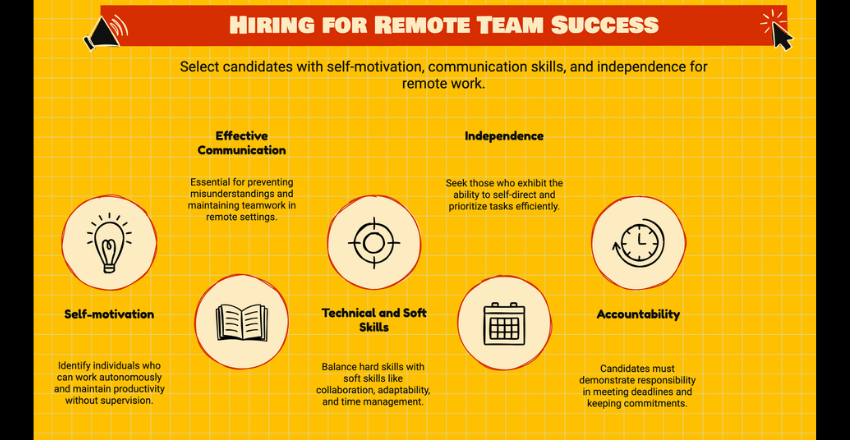Menu
March 24, 2024

Team Management in a Virtual Environment hinges on connection. Foster a sense of community, celebrate successes, and watch your team’s efficiency soar.
Managing a remote team presents unique challenges that require effective team management strategies. In a virtual environment, factors such as decreased productivity, misunderstandings in task assignments, depersonalization, and blurred work-home boundaries can hinder team coordination and performance.
Table of Contents
Toggle
Implementing flexible work hours can be a game-changer for remote teams, fostering increased productivity and better team coordination. By allowing team members to choose their work hours, organizations can accommodate individual preferences and optimize performance.
Here are some key benefits of flexible work hours for remote teams:
Implementing flexible work hours can bring numerous benefits to remote teams, including improved work-life balance, enhanced team coordination, and increased productivity. By allowing individuals to personalize their work schedule, organizations can create a positive and empowering work environment that maximizes performance and fosters better collaboration among team members.
Virtual teams training equips remote team members with the necessary skills and knowledge to excel in a virtual working environment. Managing a team remotely poses unique challenges, such as decreased productivity, task misunderstandings, depersonalization, and blurred work-home boundaries.
To overcome these challenges, organizations must invest in comprehensive training programs that address the specific needs of remote teams.
Training programs for virtual teams should focus on enhancing essential skills such as communication, time management, collaboration, and self-motivation.
These programs can be delivered through online courses, webinars, or interactive workshops to provide team members with the flexibility to learn at their own pace. By gaining proficiency in these skills, remote team members can effectively navigate the complexities of working in a virtual environment.
Additionally, virtual teams training should also emphasize the use of communication and collaboration tools. Team members should be trained on how to leverage technology platforms for seamless communication, project management, and workflow efficiency.
By harnessing the power of these tools, remote team members can stay connected, share information, and collaborate effectively regardless of geographic distances.
| Training Topic | Training Objective |
|---|---|
| Effective Communication in a Virtual Environment | Enhance remote team communication skills, ensure clarity, and minimize misunderstandings. |
| Time Management and Productivity | Equip team members with strategies to manage time effectively, prioritize tasks, and maintain productivity while working remotely. |
| Collaboration Tools and Platforms | Introduce team members to various communication and collaboration tools, ensuring they can effectively utilize technology platforms. |
| Building Trust and Team Cohesion | Promote trust, camaraderie, and a sense of belonging among remote team members to foster collaboration and engagement. |
By investing in virtual teams training, organizations can empower their remote team members to navigate the challenges of remote work successfully. With the right skills, knowledge, and tools at their disposal, remote team members can thrive in a virtual environment, achieving both individual and collective goals.

Creating a reward-driven environment is vital for fostering motivation and engagement within remote teams. In a virtual work setting, where physical interactions are limited, it is crucial to recognize and reward the achievements of team members to maintain their enthusiasm and commitment.
By implementing a reward system, remote teams can enhance collaboration, boost productivity, and create a positive work atmosphere.
One effective approach to nurturing a reward-driven environment is to establish clear goals and milestones for team members. By defining specific targets and benchmarks, team members have a clear understanding of what is expected of them and can work towards achieving those objectives.
Rewarding the attainment of these goals, whether it is through financial incentives, recognition, or career development opportunities, can motivate remote team members to strive for excellence.
Another way to foster a reward-driven environment is to encourage peer recognition and appreciation. Remote teams can create platforms or channels where team members can publicly acknowledge their colleagues’ accomplishments and contributions. This not only enhances team spirit but also reinforces a culture of support and collaboration.
| Reward-driven Environment Strategies: | Benefits: |
|---|---|
| Establishing clear goals and milestones | Enhances focus and motivation |
| Providing financial incentives, recognition, and career development opportunities | Increases job satisfaction and loyalty |
| Encouraging peer recognition and appreciation | Fosters a positive and collaborative work culture |
It is also important to note that rewards do not always have to be monetary. Remote teams can explore non-financial incentives such as additional time off, flexible work arrangements, professional development opportunities, or personalized gifts that demonstrate appreciation and value. The key is to understand the preferences and needs of individual team members and tailor the rewards accordingly.
Creating a reward-driven environment plays a crucial role in nurturing motivation and engagement within remote teams. By setting clear goals, providing incentives, encouraging peer recognition, and considering individual preferences, remote teams can cultivate a positive work culture and foster the commitment and enthusiasm necessary for success.
Effective coordination and communication across different time zones are essential for successful remote project control. When managing a virtual team, it is crucial to find ways to schedule meetings that accommodate team members in various locations. This can be challenging, but with careful planning and the right tools, it is possible to create a conducive environment for collaboration.
To ensure that all team members can participate in meetings, it is important to consider the different time zones and find a suitable meeting time that works for everyone. This may require some flexibility from all team members, but it is a necessary step to foster effective communication and maintain project progress.
One approach to organizing meetings across time zones is to use a scheduling tool that can automatically convert meeting times to different time zones. This eliminates the need for manual calculations and ensures that everyone is on the same page when it comes to meeting times. Additionally, utilizing a shared calendar that displays the availability of each team member can help in identifying overlapping time slots for meetings.
It is also helpful to establish clear communication guidelines when scheduling meetings across time zones. This includes setting expectations regarding response times, providing agenda and meeting materials in advance, and recording meetings for those who are unable to attend.
These measures promote transparency and inclusivity, enabling team members to stay informed and engaged, regardless of their geographical location.
| Meeting Time | Location |
|---|---|
| 8:00 AM | New York (EST) |
| 2:00 PM | Paris (CET) |
| 9:00 PM | Tokyo (JST) |
By prioritizing efficient communication and taking into account the unique needs of team members in different time zones, remote teams can successfully coordinate meetings and maintain effective project control. Adapting to the challenges of time zone differences shows a commitment to collaboration and can contribute to the overall success of the team.

Regular progress reports provide valuable insights into the performance and progress of remote teams, facilitating efficient project management. In a virtual team environment, where face-to-face interactions are limited, progress reports serve as a crucial tool for maintaining transparency and accountability among team members.
By providing a snapshot of individual and collective achievements, these reports enable team leaders to assess the overall progress, identify potential bottlenecks, and make informed decisions.
One effective way to structure progress reports is by including key metrics and milestones that align with the project objectives. This allows team members to track their own progress and understand their contributions in relation to the broader goals. By setting clear expectations and timelines, progress reports promote a sense of urgency and responsibility, driving team members to meet targets and deliver quality work.
Furthermore, progress reports offer an opportunity for team members to reflect on their own performance and identify areas for improvement. By providing constructive feedback and suggestions for growth, team leaders can help individuals enhance their skills and maximize their potential. This fosters a continuous learning culture within the team and encourages professional development.
Progress reports play a crucial role in tracking the performance of remote teams and ensuring efficient project management. By embracing the use of progress reports, virtual teams can maintain transparency, accountability, and productivity, ultimately leading to successful project outcomes.
Effective utilization of communication and management tools is crucial for remote software teams and distributed team management. These tools play a vital role in enhancing collaboration, streamlining project management, and improving overall workflow efficiency.
In a virtual work environment, where face-to-face interaction is limited, the right tools can bridge the physical distance and facilitate seamless communication and collaboration among team members.
One of the key tools for remote teams is video conferencing software. Platforms like Zoom, Microsoft Teams, and Slack enable real-time communication, allowing team members to connect and interact as if they were in the same physical location. Through video conferencing, virtual teams can conduct meetings, brainstorm sessions, and presentations, fostering a sense of connection and engagement.
Project management tools are also essential for remote teams. These platforms, such as Asana, Trello, and Jira, enable task assignment, progress tracking, and deadline management. They provide a centralized hub where team members can collaborate, share files, and update project status, ensuring that everyone is on the same page and tasks are completed on time.
Additionally, collaborative document editing tools like Google Docs and Microsoft Office 365 facilitate real-time collaboration on documents, spreadsheets, and presentations.
These tools allow multiple team members to work on the same file simultaneously, eliminating version control issues and streamlining the editing process.
| Communication and Management Tools | Benefits |
|---|---|
| Video conferencing software | Facilitates real-time communication and enhances team collaboration |
| Project management tools | Enables task assignment, progress tracking, and deadline management |
| Collaborative document editing tools | Facilitates real-time collaboration on documents, spreadsheets, and presentations |
By leveraging these communication and management tools, remote teams can overcome the challenges of distance and effectively collaborate on projects. The use of video conferencing software fosters a sense of connection and enables face-to-face communication, while project management tools ensure efficient task management and progress tracking.
Collaborative document editing tools facilitate seamless collaboration on shared files, promoting productivity and streamlining the editing process. With the right tools in place, remote teams can thrive and achieve success in their virtual work environment.

Building a successful remote team starts with finding the right people who possess the necessary skills and qualities for remote work. With the unique challenges that come with managing a remote workforce, it is crucial to select team members who are self-motivated, proactive, and adaptable.
Technical skills are important, but equally important are soft skills like effective communication, collaboration, and time management.
One of the key aspects to consider when hiring for remote teams is the ability to work independently and stay motivated without constant supervision. Remote work requires individuals who can take initiative, prioritize tasks, and meet deadlines without direct oversight. By finding candidates with a strong sense of accountability and self-discipline, you can ensure that your remote team remains productive and efficient.
Not only do remote team members need to be self-sufficient, but they also need to be excellent communicators. Effective communication is vital in a remote work environment, as it helps to prevent misunderstandings, maintain transparency, and foster collaboration. Look for candidates who are comfortable expressing themselves clearly and concisely, both in written and verbal communication.
| Key Qualities for Remote Team Members |
|---|
| Self-motivation and accountability |
| Strong communication skills |
| Adaptability and flexibility |
| Excellent time management |
| Problem-solving and decision-making abilities |
In addition to these qualities, it is essential to assess a candidate’s technical skills and experience related to the specific role. Remote teams rely heavily on technology and digital tools for collaboration, so candidates should be comfortable using virtual communication platforms, project management software, and other remote work tools.
By carefully selecting candidates who possess the right skills, qualities, and experience for remote work, you can build a strong and high-performing remote team. Remember that finding the right people is just the first step; ongoing support, collaboration, and effective leadership strategies are crucial to ensure the success of your remote team.
Fostering a virtual team culture is essential for effective remote team coordination and supervision. Managing a virtual team in a remote environment presents various challenges, such as decreased productivity, misunderstanding tasks, depersonalization, and blurred work-home boundaries.
To overcome these challenges, it is crucial to establish a strong team culture that promotes collaboration, engagement, and a sense of belonging among remote team members.
One way to foster a virtual team culture is to emphasize clear communication and regular interactions. Encouraging team members to communicate openly and frequently can help build trust and enhance coordination.
Implementing communication tools, such as instant messaging platforms and video conferencing software, can facilitate real-time conversations and promote a sense of connection despite physical distances.
Another important aspect of fostering a virtual team culture is creating opportunities for social interaction and building rapport. Remote team members may miss out on the informal conversations and socializing that usually occur in a traditional office setting.
To counteract this, virtual teams can organize online team-building activities, virtual coffee breaks, or even non-work-related chat channels. These initiatives promote camaraderie, strengthen relationships, and create a more inclusive work environment.
Furthermore, providing a platform for recognition and appreciation is crucial for fostering a virtual team culture. Remote team members often work independently and may not receive immediate feedback or recognition for their contributions.
Implementing a reward system, such as employee recognition programs or virtual shout-outs, can boost morale, motivation, and overall team performance. By acknowledging and celebrating the achievements of remote team members, organizations can create a positive and motivating work environment.
| Key Strategies for Fostering a Virtual Team Culture |
|---|
| Emphasize clear communication and regular interactions |
| Create opportunities for social interaction and building rapport |
| Implement a reward system to recognize and appreciate remote team members |
Fostering a virtual team culture is crucial for effective remote team coordination and supervision. By prioritizing clear communication, social interaction, and recognition, organizations can create an environment that enhances collaboration, engagement, and productivity among remote team members.
Combining these strategies with the effective use of technology and communication tools can position remote teams for success in a virtual work environment.

Successfully managing a distributed team requires understanding and addressing the personal needs of remote team members. Working remotely presents unique challenges that can impact an individual’s well-being and productivity. By recognizing and accommodating these needs, team leaders can foster a positive work environment and promote the success of their remote teams.
One important aspect is providing flexibility in work schedules. Remote team members may have different time zones, childcare responsibilities, or other personal commitments.
Allowing flexible work hours enables individuals to find a balance between work and personal life, enhancing their overall job satisfaction and motivation. It also promotes better collaboration by ensuring that team members can connect and communicate during overlapping hours.
Another key consideration is the provision of adequate support and resources. Remote team members may experience feelings of isolation or disconnection from their colleagues. Regular check-ins, one-on-one meetings, and team-building activities can help create a sense of belonging and foster strong relationships within the team.
Additionally, providing access to relevant training programs and tools can enhance skill development and ensure that team members have the necessary resources to perform their tasks effectively.
Open and transparent communication is crucial in remote teams. Leaders should encourage team members to voice their concerns, ask for help when needed, and provide regular feedback on performance.
By creating a safe and supportive environment, remote team members will feel valued and empowered to contribute their best work. Setting clear expectations, goals, and milestones also helps in promoting accountability and driving productivity.
| Key Strategies for Understanding and Addressing Personal Needs: |
|---|
| 1. Providing flexible work hours: Allow team members to choose their work schedules to accommodate personal commitments and time zone differences. |
| 2. Offering support and resources: Regular check-ins, one-on-one meetings, and team-building activities can help foster a sense of belonging and connection. |
| 3. Encouraging open communication: Create a safe and supportive environment for team members to express concerns, ask for help, and provide feedback. |
| 4. Setting clear expectations: Define goals, milestones, and performance indicators to promote accountability and drive productivity. |
By understanding and addressing the personal needs of remote team members, leaders can foster a positive work culture, boost engagement, and drive the success of their distributed teams.
Investing in the well-being and professional development of team members not only enhances individual performance but also contributes to the overall productivity and success of the team.
Regular one-on-one meetings play a crucial role in fostering effective communication and collaboration within remote software teams. These meetings provide an opportunity for team members to discuss their progress, address any challenges they may be facing, and receive feedback and guidance from their supervisors.
Despite the physical distance between team members, these meetings help build trust and strengthen relationships, ensuring everyone feels heard and supported.
When organizing one-on-one meetings in remote teams, it is important to establish a consistent schedule that works for both parties. This allows team members to plan their workload and ensures that meetings are not overlooked or rushed.
Utilizing video conferencing tools can enhance the virtual meeting experience, providing a face-to-face interaction that helps in establishing a personal connection.
During these meetings, supervisors should encourage open and honest communication. This means actively listening to team members’ concerns and providing constructive feedback. It is important to create a safe space where team members feel comfortable sharing their ideas, challenges, and aspirations.
These meetings also provide an opportunity to set goals, review performance, and align expectations, ensuring everyone is on the same page.

Leveraging technology is vital for ensuring remote project control and efficient distributed team management. Managing a virtual team in a remote environment presents various challenges, such as decreased productivity, misunderstanding tasks, depersonalization, and blurred work-home boundaries. However, there are strategies to overcome these challenges and optimize team collaboration.
One key aspect is utilizing communication and management tools that facilitate seamless interaction and streamline workflow. Platforms like Slack, Microsoft Teams, and Basecamp allow teams to communicate in real-time, share files, and track project progress. These tools promote efficient collaboration, ensuring that team members can easily exchange ideas and stay updated on project developments.
Additionally, project management systems such as Trello and Asana help distribute tasks, set deadlines, and monitor progress. These tools enable team members to have a clear overview of the project’s status, ensuring accountability and efficient remote project control.
Furthermore, leveraging video conferencing tools like Zoom or Google Meet is essential for fostering effective communication in virtual teams. These platforms facilitate virtual meetings, allowing team members to connect face-to-face, discuss project details, and address any concerns or questions. Video conferences help maintain a sense of connection and reduce misunderstandings that may arise from purely written communication.
https://global.hitachi-solutions.com/blog/manage-virtual-teams/
https://www.genioo.com/en/insights/articles/remote-control-managing-projects-in-a-virtual-world/
How do you build trust within a virtual team? Start with open communication. Encourage video calls to add a personal touch. Set clear expectations. Regular one-on-ones help. Recognize and celebrate achievements publicly. This approach strengthens trust.
What’s the biggest challenge in managing a team virtually, and how can it be overcome? Communication gaps are common. Overcome this by setting up regular check-ins. Use project management tools. Ensure everyone’s on the same page. Make room for informal virtual gatherings too.
Can team culture thrive in a virtual environment? Yes, with effort. Create virtual spaces for casual chats. Host online team-building activities. Celebrate milestones and successes. A positive, inclusive culture can indeed flourish virtually.
Input your search keywords and press Enter.